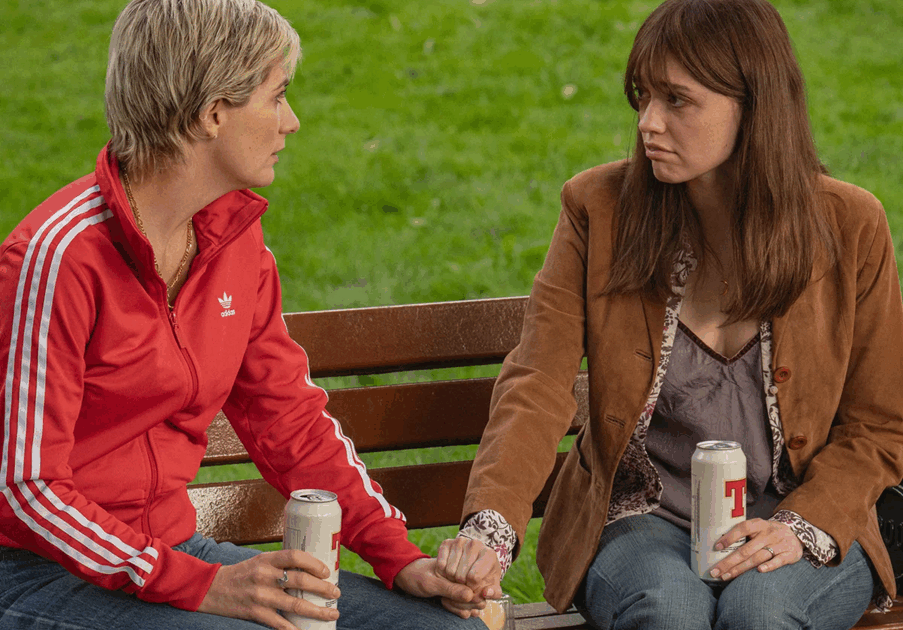Jodie Whittaker as Susan and Aimee Lou Wood as Tracey in Toxic Town. Photograph: Ben Blackall/Netflix via The Guardian
Amber Ward is a tutor in Modern History at the University of St Andrews.
A longer version of this review was originally published in French in Contretemps, and is available to read online here.
_
In 1996 in the English town of Corby, Northamptonshire, two women – Susan and Tracy – have given birth on the same day. Out in the town, toxic waste from the disused steelworks is being hurtled along residential roads in open-top trucks, part of a cleanup operation that commenced a year before. Plumes of waste land on residential windows; it congeals on car windshields; it gets embedded into the clothes of the cleanup workers themselves. Later on we learn that Susan and Tracy’s babies were born with birth defects, as were a number of other children born to local mothers around the same time.
Based on true events, Netflix’s Toxic Town follows the Corby mothers who fought for justice in what became a landmark toxic waste scandal and court case. It is their search for answers that guides us a through a web of political corruption in Corby Borough Council, the local authority, under Tony Blair’s neoliberal ‘New Labour’ leadership. As the Corby mothers contend with their harrowing experiences, a parallel story unfolds in the Borough Council: a clique of New Labour councillors are covering up the dodgy deals they issued to profit-hungry private firms to ‘reclaim’ the poisoned land. But pockets of resistance start to bubble within the Borough Council too, when an ‘Old Labour’ stalwart and assiduous young whistleblower form a reluctant reliance to fight back. The four-part series charts the Corby mothers’ long campaign for justice between 1996 and 2009.
Toxic Town is a humane account of community injustice, agency, and campaigning. It is also an unusual story about an industrial town, set at the moment when such stories often come to an end: high globalisation. By placing motherhood and domestic labour at the centre of a story about a steel town, Toxic Town shows how working-class consciousness persisted through and beyond the concentrated industrial contraction of the late twentieth century. It illuminates how domestic spaces such as the home, hospitals, and community halls – sites of reproductive labor – are crucial sites of exploitation and resistance, just as much as the workplace and the picket line.
The history of Corby will be familiar across industrialised nations of the West. The town sits in the East Midlands of England, between the major cities of Birmingham and London. The town’s industrialisation was unusually late. It remained a small village until the 1930s when the first steelworks were founded there by Stewarts & Lloyds, during the height of the Great Depression. Migrants from depressed areas in Scotland and Ireland flocked for work at Corby’s steelworks up until the Second World War. Then in the 1950s the town and its steel industry grew again, this time as a designated ‘New Town’ expanded as part of Britain’s post-war reconstruction strategy. Corby became known as ‘Little Scotland’ for its large number of Scottish immigrants – many of the characters in Toxic Town speak with Scottish accents. Britain’s steelworks were brought into public ownership in 1967 under British Steel, but plans for gradual restructuring were abandoned in the 1980s under Margaret Thatcher’s Conservative Party premiership. Corby’s steelworks were closed in 1980 and local unemployment rocketed to over 30%. Unemployment had eased somewhat by the 1990s, but the poisoned land from the steelworks remained.
The literary scholar Sherry Lee Linkon encourages us to consider how the effects of deindustrialization persisted long beyond the closure of a plant, factory, or pit. She compares the consequences of deindustrialization to radioactive waste, borrowing a term from chemistry to argue that deindustrialization has a ‘half-life’: the slow time it takes for toxicity to break down. The half-life of deindustrialization can be seen in many industrial communities across the globe which continue to be blighted by long-term unemployment, industrial illness, and environmental ruin.
These themes underpin the plot of Toxic Town, and the show does well to grapple with these issues sensitively without painting its characters as downtrodden victims. In fact one of my favourite aspects of the show was how it portrayed working-class womanhood at the turn of the twenty-first century: confident and empowered, but also shy and scared. Despite its sensitive subject matter, the Corby mothers are never reduced to flat notions of ‘biological’ essence nor to maternal ideals. We see them as whole beings, navigating freedoms in work, money, and sex, newly won by women merely a generation before.
That being said there are no shortage of other clichés. Some moments of dialogue and form are, well, very cheesy, and we are generally spoon-fed the characters and plot. I liked Jodie Whittaker and Amy-Lou Wood’s portrayal of the two leads, Susan and Tracy – who are based on real people – although the binary distinctions drawn between their characters sometimes played into harmful stereotypes of gender and class. Susan is messy, loud, speaks her mind. Her blue-collar boyfriend leaves when he learns of his son’s disability. Tracy is a reserved, forward-planning accountant. Her caring husband supports her through thick and thin.
On the whole though, Toxic Town is an entertaining watch about an important moment in feminist and working-class history: two struggles that are often siloed in mainstream British film and TV. It is a compelling and accessible series that brings these histories – and their lessons – to a broad public audience. Amidst renewed uncertainties about the future of global steel production, the show offers a stark warning against policies that put profit before people. Let’s hope that this time the message gets through.





